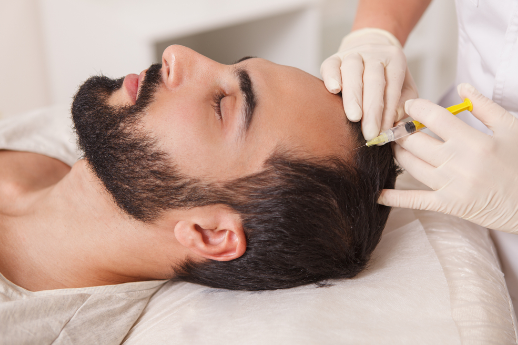
Platelet Rich Plasma (PRP) Hair Restoration
Platelet-rich plasma (PRP) hair restoration is a non-surgical treatment that uses a patient’s own blood to stimulate hair growth:
Highly effective, the procedure is non-surgical, takes less than 30 minutes with minimal discomfort or downtime. Discover what you’ve been waiting for!
What is PRP Hair Restoration?
Platelet Rich Plasma (PRP) treatments are gaining popularity in treating a wide range of conditions, including hair loss. PRP can be effective in preventing hair loss and promoting new hair growth in both men and women. PRP can also aid in the stimulation of hair growth after hair transplants. Using a patient’s own blood, a concentrated solution of platelets and plasma is developed and injected into target areas being treated.
What does PRP Hair Restoration do?
PRP injections are an effective treatment for hair loss both in preventing further loss and creating new hair growth. But the procedure does have a wide range of applications, including other cosmetic procedures including.
Treating surgical scars
Reducing the appearance of wrinkles and fine lines
Improving skin tone and texture
Plumping up sagging skin
Diminishing acne scars
Treating surgical scars
How does PRP Hair Restoration work?
Clinicians take a blood sample from the patient and place it into a device called a centrifuge that rapidly spins the sample, separating out the other components of the blood from the platelets and concentrating them within the plasma, creating a platelet rich plasma solution.
That solution is injected into the target area to increase the concentration of specific bioproteins or hormones, called growth factors, in a specific area to accelerate the healing and growth processes.
What can I expect?
A Platelet-Rich Plasma (PRP) hair loss treatment session typically takes 60 to 90 minutes. The entire process includes:
Injection: The platelet-rich plasma is injected into the scalp.
Blood draw: A small blood sample is drawn from your arm.
Blood processing: The blood is spun in a centrifuge to separate the components by weight. The red and white blood cells are discarded, and the platelets and plasma are combined.
The number of sessions needed depends on your individual needs and response to treatment, but most patients require three to four sessions spaced four to six weeks apart. You may start to notice improvements in hair thickness and texture after a few months, but it can take up to six to twelve months to see significant results. You may notice some local irritation, but generally recovery time is minimal.
What is the next step?
Book a consultation with your local medspa810 to find out more about our PRP hair restoration!
What Our Clients Are Saying…

JL. (Washington, DC)
5 stars
Krissy Williamson
5 stars
